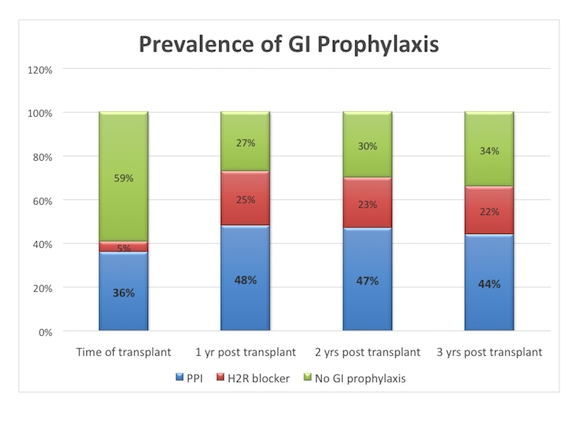Proton Pump Inhibitor Use among Kidney Transplant Recipients
Vanderbilt University Medical Center, Nashville, TN.
Meeting: 2018 American Transplant Congress
Abstract number: D109
Keywords: Adverse effects, Kidney transplantation
Session Information
Session Name: Poster Session D: Kidney Complications: Late Graft Failure
Session Type: Poster Session
Date: Tuesday, June 5, 2018
Session Time: 6:00pm-7:00pm
 Presentation Time: 6:00pm-7:00pm
Presentation Time: 6:00pm-7:00pm
Location: Hall 4EF
Background: Proton Pump Inhibitors (PPIs) have been associated with CKD and other serious adverse effects. PPI use in the transplant population has not been well-described. We hypothesized that the use of this potentially toxic drug is highly prevalent and largely inappropriate.
Methods: We retrospectively reviewed adults who received a kidney transplant at an academic center from 6/2011-6/2012. Characteristics at time of transplant and 1, 2 and 3 years posttransplant were collected via chart review. Based on a reconciled medication list, patients were categorized as using PPIs, H2-receptor blockers or no GI prophylaxis. Prevalence of GI prophylaxis for each category was calculated at the predefined time points. Indications for PPI use were collected via chart review. Pearson's chi-squared, Fisher's exact test and One-way ANOVA were utilized to compare groups. Multivariate logistic regression was performed to identify characteristics that were associated with the use of PPIs.
Results: 159 patients were included with the following characteristics: age 49 yrs, 64% male, 64% white, 28% DM, 25% CV disease, BMI 28, 36% living donor, 7% DGF, 85% alemtuzumab induction, 46% rapid steroid withdrawal, 95% FK/MMF-based immunosuppression. Mean follow-up was 4.9 yrs with 87%/94% graft/patient survival rates (median time to graft loss and death both 3 yrs). Mean serum Cr for patients with functioning grafts at 3 yrs posttransplant was 1.5 mg/dL.
There were no significant differences in characteristics among the 3 groups. Prevalence of GI prophylaxis is shown (figure) and was significantly different between the 4 time points (p<0.001). 66% of PPIs were prescribed for GERD while 31% had no clear indication. Multivariate logistic regression did not show any significant association between predictors and PPI use at any of the predefined time points.
Conclusions: The high prevalence of PPI use among kidney transplant recipients persists for at least 3 years posttransplant. No clear indication for its use could be identified in 1/3 of the patients studied. The indication for PPI use in kidney transplant recipients warrants repeated scrutiny to ensure that its use is appropriate, thus avoiding unnecessary risk and cost.
CITATION INFORMATION: Wilson N., Bala S., Concepcion B. Proton Pump Inhibitor Use among Kidney Transplant Recipients Am J Transplant. 2017;17 (suppl 3).
To cite this abstract in AMA style:
Wilson N, Bala S, Concepcion B. Proton Pump Inhibitor Use among Kidney Transplant Recipients [abstract]. https://atcmeetingabstracts.com/abstract/proton-pump-inhibitor-use-among-kidney-transplant-recipients/. Accessed December 24, 2025.« Back to 2018 American Transplant Congress

